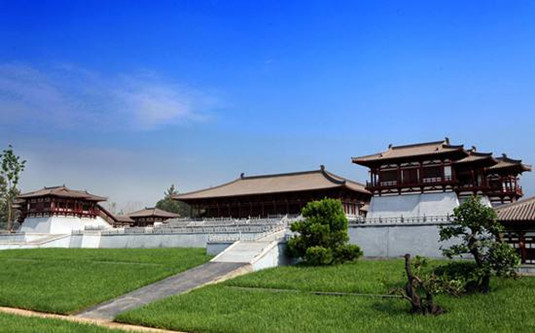Tasting Oriental Verve
As the political center and national symbol, with total area of about 3.5 square kilometers, Daming Palace of Tang Dynasty is the masterpiece among ancient palace architectures in China. The layout pattern of palace architecture complex created by Daming Palace laid the palace system of ancient China and is also the model for palace architectures in China since Tang Dynasty. Daming Palace is the best preserved royal sites in China at present and has also been selected into the first batch of National Key Cultural Protection Units as its highly historical, scientific and artistic value. Besides, it was listed into Tentative List of World Cultural Heritage in China as the major project of “Silk Road”- Transnational Application of World Heritage.

Daming Palace of Tang Dynasty is the most glorious architectural complex among the world famous “three great palaces” (Taiji Palace,Daming Palace and Xingqing Palace) of Chang’an City in Tang Dynasty. As the outstanding representative of oriental garden architectural arts and important place for harmonizing the whole country of China, it is also called as the oriental holy temple of “Silk Road”.
Daming Palace, initially built in the 8th year of Zhenguan Period (634A.D.), was the summer palace built by Emperor Taizong Li Shimin of Tang Dynasty for his father Li Yuan and its original name was Yong’an Palace. As Li Yuan died before its completion and then it renamed as Daming Palace. In the 2nd year of Longshuo Period (662 A.D.), Emperor Gaozong expanded it and once renamed as Penglai Palace and Hanyuan Palace. In the 1st year of Shenlong Period (705A.D.), it was called to the original name as Daming Palace.
Daming Palace was slightly ladder-shaped and was laid as “political hall in the front and harem at the back”. The central axis is from the Danfeng Gate in the south end to Taiye Pool. The south palace is centered as the HanyuanTemple, Xuanzheng Temple, Zichen Temple and other governmental temples (middle temple) and YanTemple (inner temple) from south to north and with Secretariat Department and Chancellery Department as well as Hongwen Pavilion and Hongshi Pavilion on its both sides. Besides, there are also wing-temples, pavilions, decks and other more than 20 buildings.
Hanyuan Temple
As the main temple of Daming Palace, many important celebrations and rites were held in HanyuanTemple. There are 11 rooms with 76 meters in the foundation of the temple and 4 rooms with above 40 meters deep and 15 meters currently, which fully embody the magnificent momentum of “diplomatic envoys of various countries and hundreds of officials are paying their respects to the emperor through layers of imperial doors”. The imperial palace center at the north of the temple is Taiye Pool with many foundation sites of buildings including Sanqing Palace around it. It is the Linde Palace at west of imperial palace mainly used for banquets and receiving foreign ambassadors with above 130 meters long and about 80 meters wide. There are also three adjacent temples from its former, middle and back directions surrounded by winding corridors, the scale of which is very majestic.

 陕公网安备 61011202000113号
陕公网安备 61011202000113号